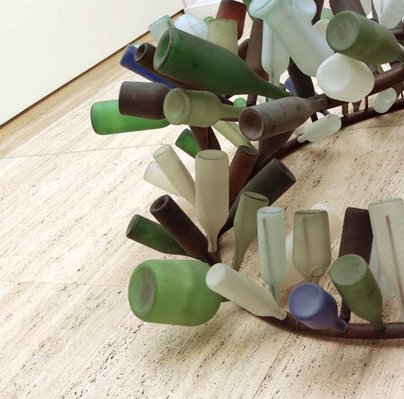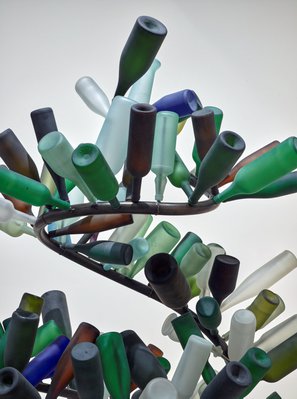



-
Details
- Date
- 1992
- Media category
- Sculpture
- Materials used
- glass and steel
- Dimensions
- 220.0 x 210.0 cm
- Signature & date
Not signed. Not dated.
- Credit
- Mervyn Horton Bequest Fund 1997
- Location
- Not on display
- Accession number
- 292.1997
- Copyright
- © Anthony Cragg
- Artist information
-
Tony Cragg
Works in the collection
- Share
-
-
About
For the past 30 years Tony Cragg has consistently produced original ideas and a remarkable diversity of forms employing a vast array of materials and techniques. It is difficult to characterise his work within a specific style or art movement.
In the early 1970s a new generation of British sculptors celebrated a certain freedom from the snares of style which had bedevilled their immediate predecessors. Under the influence of conceptual art, a pluralist environment in which almost anything could happen began to flourish. Conceptual artists proclaimed the subservience of material form to content, thereby allowing any material or method to be employed in their service. Some artists took this dictum to devalue the material properties of ‘fine art’ and began privileging media associated with popular culture, including text, photography and video over more traditional materials. Cragg, by contrast, was among those who translated this freedom into an infinite possibility for systems and material processes with which to conjure new and provocative objects. In this he had more in common with the European arte povera artists than with Transatlantic conceptualism. His early works included materials such as coloured plastic fragments found along the Thames embankment, old furniture and machine parts. These were always ordered according to precise systems reflecting both his scientific orientation and the working ethic of rigorous systems and logical processes that prevailed in British art schools at the time. In Cragg’s work, however, there was always room within this order for random variation, just as there is in nature. Paradoxically the limitation imposed by these systems was liberating because they replaced the constraints of reproducing appearances on the one hand and the formal recipes of basic design on the other. Working within these systems, artists could incorporate all manner of material, even celebrating excesses of material diversity without losing the logic of the form.
‘Spyrogyra’ captures the general good humour of Cragg’s sculpture while embodying some of the most profound aspects of his work as a whole. The bottle rack is of course a reference to Duchamp’s famous Readymade, ‘Egouttoir’ (bottle rack) 1914 1; this alludes to the playful conceptual aspect of Cragg which so often makes witty allusions to art history. The structure is however far more open and intuitive than Duchamp’s original. The spiral immediately suggests DNA and organic couplings, which are ubiquitous in Cragg’s forms. Each rod attached to the spiral can take certain kinds of bottles, not a unique bottle but one of a general kind. As a result every time it is assembled it changes in the particular but maintains its essential form. In this way it mimics the genetic accommodation of kind and individuality. The reference to scientific structures is invariably a key theme in Cragg’s work.
1. Or, literally ‘detaster’, a play on the idea of the readymade as a challenge to taste in art
© Art Gallery of New South Wales Contemporary Collection Handbook, 2006
-
Audio
Spyrogyra - Tony Cragg 1:48
-
Exhibition history
Shown in 2 exhibitions
Tony Cragg, Art Gallery of New South Wales, Sydney, 10 Jun 1997–10 Jul 1997
Tony Cragg, Queensland Art Gallery, South Brisbane, 20 Sep 1997–23 Nov 1997
Tony Cragg, City Gallery Wellington, Wellington, 13 Feb 1998–29 Mar 1998
Reinventing the wheel: the readymade century, Monash University Museum of Art, Caulfield East, 03 Oct 2013–14 Dec 2013
-
Bibliography
Referenced in 7 publications
-
Anthony Bond, Look, 'Marriage rites', pg.28-31, Sydney, Jul 2008, 31 (colour illus.).
-
Anthony Bond, Contemporary: Art Gallery of New South Wales Contemporary Collection, 'Objects and associations', pg.332-381, Sydney, 2006, 344, 345 (colour illus.).
-
Anthony Bond OAM, Jim Potts and Robert Hopper, Tony Cragg, Sydney, 1997, 38, 39 (colour illus.).
-
Laura Murray Cree (Editor), Art and Australia (Vol. 35, No. 2), Sydney, 1997, 260 (colour illus.).
-
Charlotte Day, Reinventing the wheel: the readymade century, 'Introduction', pg.85-88, Melbourne, 2013, 65 (colour illus.), 86.
-
Geoffrey Edwards, Art Monthly Australia, 'Rosslynd Piggott and Tony Cragg: a short note on glass imagery', pg.24-25, Canberra, Jun 2000, 25 (illus.).
-
Julia Marshall, Integrating the visual arts across the curriculum - An elementary and middle school guide, New York, 2019, 37 (colour illus.).
-
